Many people are starting to go into polyhouse farming. Despite a slow beginning, its fame has recently increased. Using this technique, a farmer can significantly increase their income. Read on to find out how one vegetable grower in Telangana’s Rangareddy district used a polyhouse to grow coriander effectively. We’ll learn about his cultivation, profits, investments, and experiences. Let’s check out earning 1.3 lakh rupees from coriander cultivation in polyhouse below.
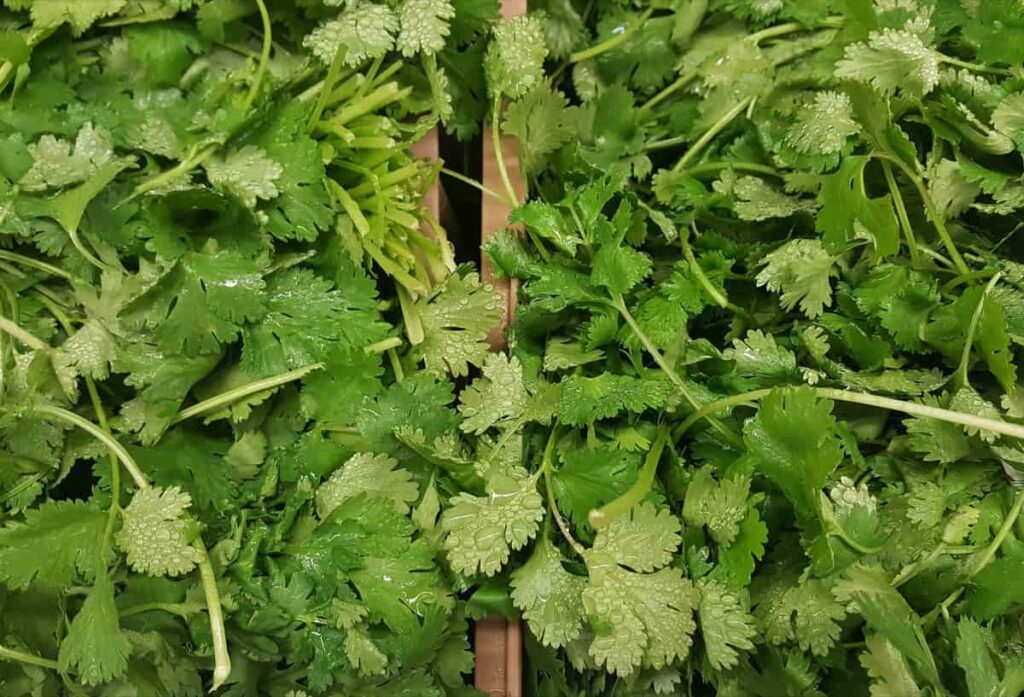
What is a polyhouse?
A polyhouse is a greenhouse used to cultivate various plants and other agricultural purposes; it is typically constructed from the transparent material polyethylene. The structural size may vary from small to large based on demands. Polyhouses are constructed from polyethylene, which traps heat from the sun and prevents the escape of greenhouse gases.
For the sake of the plants, the interior temperature is carefully controlled by hand throughout the colder months. To keep plants healthy in the face of ever-changing weather and climatic circumstances, including heat, sunlight, and wind, polyhouses serve a crucial role. The plants can now be grown at any time of year. Every aspect impacting production may be managed in polyhouse farming.
Which month is best for growing coriander?
Late in the growing season (March-early September), coriander is planted. Plant a few seeds every three weeks during the summer to ensure a steady supply of leaves. Later in the spring and later in the fall are the optimal times for leaf development. Sowing coriander seeds directly, instead of starting them in seed trays and then transferring them, is the optimum cultivation method.
The process of transplanting itself will also induce them to go to seed if they are disturbed. Plant seeds in rich, well-drained soil. Good garden compost or well-rotted manure can do wonders for soil that needs to be amended. Remove any big stones or lumps from the soil’s surface using a rake, and then work the soil until it is fine and even in tilth. Plants should have 20cm of space between them and the row, and rows should have 20cm of space between them.
In case you missed it: Greenhouse Farming in the Philippines: How to Start, Agriculture Crops, and Cost to Build
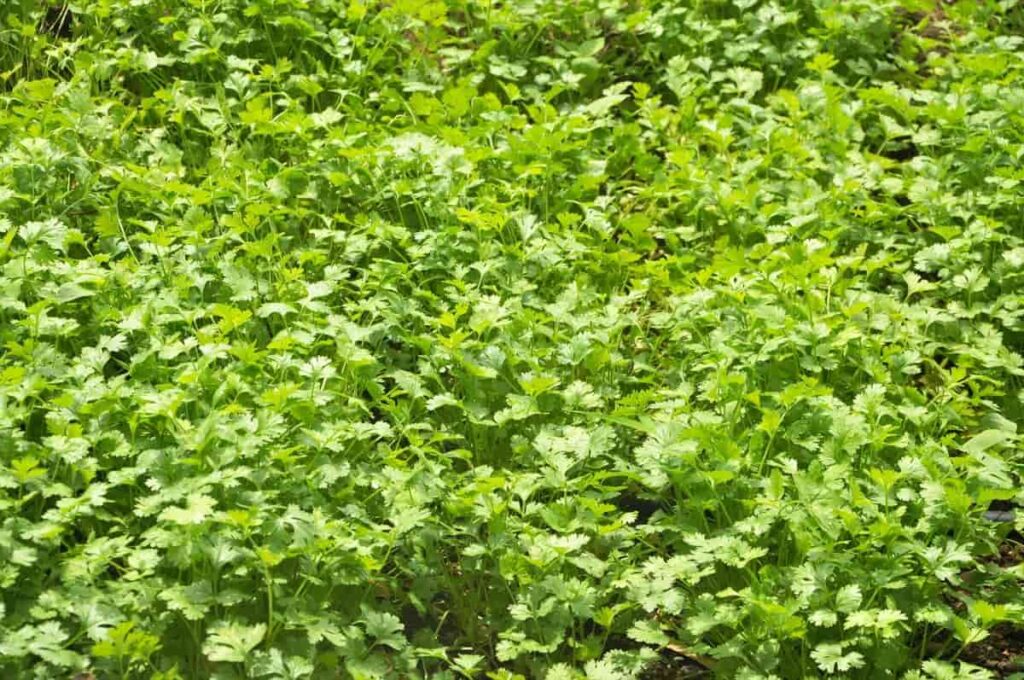
Planting coriander in containers or trays with a high-quality multipurpose compost can provide similar results. The tap roots of coriander plants are very long. Thus, their containers must be at least 25 centimeters deep. Sow seeds on top of the compost and thoroughly water them in. About five seeds may be planted in a container with a diameter of 25 centimeters.
How to plant coriander in a polyhouse?
In your polyhouse, have a small area of soil ready. Herbs may also be grown on raised garden beds or hanging pots with the help of polyhouse kits with slab bases. Composted manure should be added to the soil. Plant each seed about a quarter of an inch deep, then space them out in rows a foot apart. After roughly three weeks, coriander will begin to germinate.
Add extra compost or natural fertilizer when the plants reach a height of approximately 2 inches. A patch 5 feet by 5 feet will need around 55 grams. Because coriander thrives in arid environments, it is unnecessary to water the soil after the seeds have germinated. The herb grows rapidly, especially in polyhouses, so regular planting throughout the growing season is necessary to ensure a steady supply.
What are the advantages of polyhouse?
Because of its many positive effects on food production and environmental sustainability, polyhouse farming has quickly become a popular alternative to conventional methods. Below is a list of some of the most significant advantages of polyhouse agriculture. Plants can be cultivated even when it’s not in season. Profits from these crops tend to be greater due to the scarcity of supply and the rising price of the corresponding demand. You don’t need to follow the cycles of the seasons to harvest food for a whole year.
Reduced crop damage and loss are possible due to your careful management of environmental conditions, including humidity, temperature, sunshine, etc. When water is scarce, a drip irrigation system is a practical alternative. Improved agricultural growth is another added benefit. Pests and insects can be managed better, reducing the risk of crop failure. There has been a marked improvement in crop quality.
In case you missed it: Earning 7 Crore Rupees from Donkey Rearing Business: A Success Story of an Entrepreneur in India
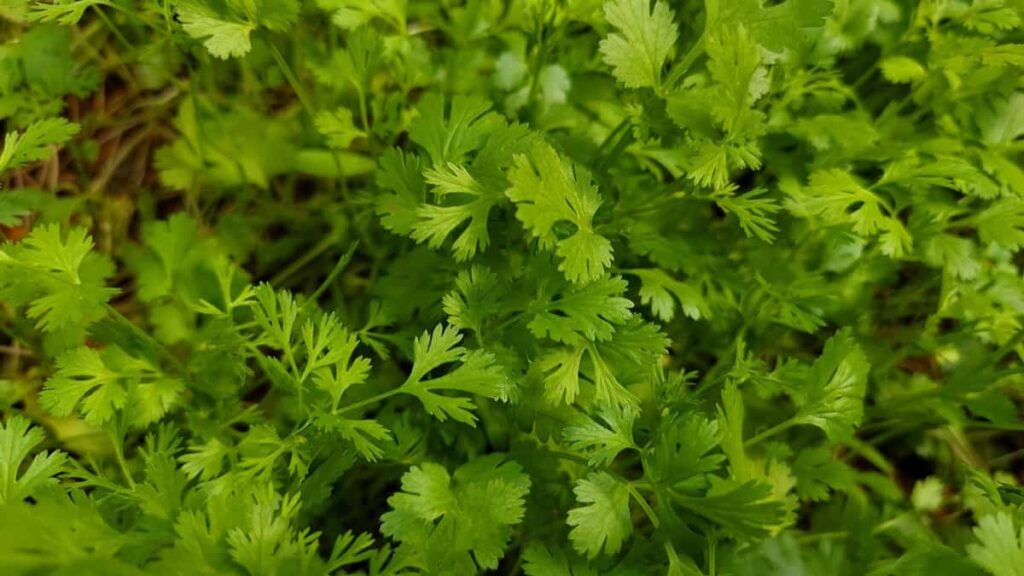
The crops are little affected by the outside environment. The crop growing conditions are improved, leading to greater yields and financial returns. Automatic solutions can be used to ensure that each plant receives the precise quantity of fertilizer it needs, simplifying the process of applying fertilizer. Farmers may harvest twice as many crops in the same time frame. More sophisticated drainage and ventilation systems may be installed in a polyhouse. As more CO2 is produced in a polyhouse, it benefits the plants within.
Is coriander best grown in a Polyhouse?
Coriander’s water needs change as the plant matures. Quite a little more water is needed when planting the herb for it to germinate. A weekly supply of around one inch (25 mm) is recommended. After the seeds have germinated, the area should be kept wet but not waterlogged. At this point, a weekly watering rate of 10–15 mm is sufficient. The ideal soil pH for growing coriander is between 6.2 and 6.8. Optimal conditions for the plant’s growth include direct sunlight.
It can grow in full sun but prefers partial shade, particularly in locations with intense heat throughout the day. Thus, cultivating Coriander in a polyhouse is a simple task. Remove the lower leaves and stems one at a time when the plant is 4 to 6 inches tall. Only remove a third of the coriander’s leaves at a time to prevent the plant from becoming weak.
What problems occur during coriander cultivation in a polyhouse?
In either freezing or scorching temperatures, coriander will perish. These two factors cause the leaves to become yellow and ultimately result in the development of seeds rather than rich greenery. To plant successfully, the soil temperature has to be kept between 60 and 80 degrees Fahrenheit, which is why late spring planting or using a polyhouse kit is recommended. Coriander is susceptible to aphid attacks, which can cause growth stunting by aggregating in swarms around the buds.
Earning 1.3 lakh rupees from coriander cultivation in polyhouse
The success story of Mr. Ashalu
Mr. Ashalu is a vegetable farmer from Rangareddy district, Telangana. Mr. Ashalu is a vegetable farmer who grows different vegetable crops. He always wanted to expand his farm but feared losing his crop due to the unpredictable climate. Even though his 2-acre farm was going fine, he wanted to expand no matter what. At such time, he consulted the agricultural officers in his district, and they told him to start polyhouse cultivation. At the start, he didn’t know what it was, but he took his time and learned about the polyhouse and the techniques to grow in it.
In case you missed it: Earning 10 Lakh Rupees from Bamboo Cultivation: A Sucess Story of a Bamboo Farmer in India
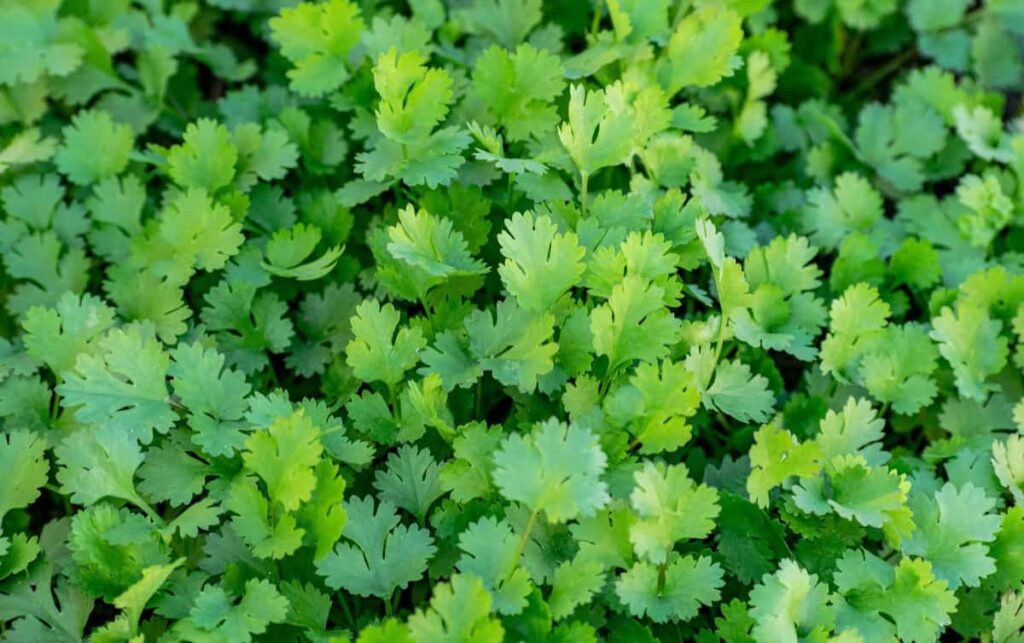
As he was at no stage to afford a polyhouse, even though with subsidy considered, he chose to lease a polyhouse. He learned that someone was ready to make him an offer in his village about the polyhouse. He talked to them, signed the agreement, and took a polyhouse on lease. As it was summer, he started cultivating coriander crops and had tremendous success. He was earning huge profits like never before from his polyhouse cultivation. Now let us know his experiences in polyhouse cultivation of coriander crops.
Polyhouse cost details, according to Mr. Ashalu
Polyhouses are a costly burden for farmers. However, Mr. Ashalu claims that if you build a poly house with the state government’s assistance, you can obtain a subsidy that covers up to 75% of the project’s total cost. It can take nearly 30 Lakhs to build a polyhouse on an acre. But with a subsidy, you can reduce this to only 10 lakh rupees per acre. Although the first investment could seem heavy, remember that you will only have to make it once.
In three years, you’ll get the money back. As a result, you can expect a swift and significant rise in your income, says Mr. Ashalu. Mr. Ashalu didn’t construct a polyhouse, as mentioned above. He took it on a lease. This saved him so much money. For someone who wants to get into this polyhouse business permanently, he says it’s best to construct a polyhouse. Mr. Ashalu pays nearly 1.2 lakh rupees as a lease to the polyhouse owners. This is very affordable to him, so he took the offer.
Coriander cultivation details, according to Mr. Ashalu
Mr. Ashalu chose coriander, particularly because in summer, coriander has a huge demand in the market. Also, coriander is a very low-maintenance crop with a very short growth period. He thought he could experiment with this short-period variety, and once he saw the positive results, he would try to cultivate different crops. Mr. Ashalu started his cultivation in march, at the beginning of the summer. He says that in summer when temperatures exceed 35 degrees Celcius the coriander crop will not germinate. This is where the polyhouse comes into play.
For land preparation, Mr. Ashalu added two bags of DAB, 1 ton of coco peat, 250 kg of vermicompost, and 50 kg of neem cake, into his land in February. After this, the land is thoroughly plowed once again to help mix all the ingredients in the soil. After this, Mr. Ashalu made 24 mounds in his one-acre polyhouse to start the cultivation. He spread the seeds in these mounds, and it took him nearly 25 kgs for his one-acre polyhouse. After planting the seeds, the ground must be kept moist for two days, says Mr. Ashalu.
In case you missed it: Earning 8 Lakh Rupees from Spine Gourd Cultivation: A Success Story of Kantola/Teasle Gourd Farmer in India
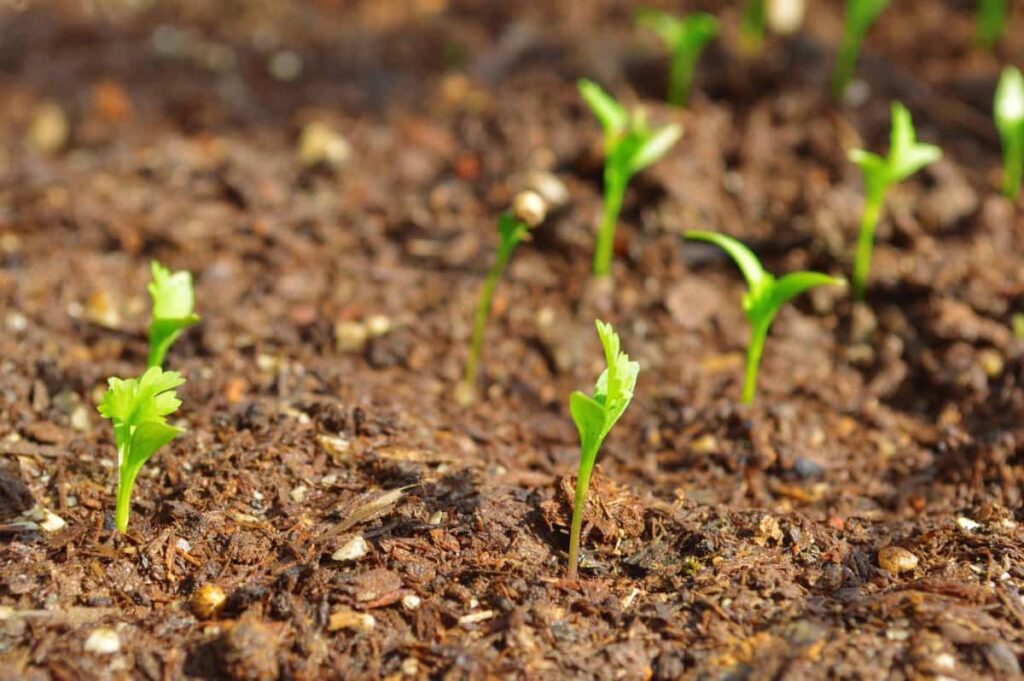
For watering, Mr. Ashalu used the drip irrigation system in his polyhouse. He says drip irrigation is ideal for watering in the polyhouse as it reduces water waste and gives plants only the required amount of water needed, not more. To keep the temperature in control, Mr. Ashalu used foggers in his polyhouse. These foggers are attached at the top, inside the polyhouse, and will mist water to keep the temperature in control.
In this way, he added that one could easily keep the temperature below 35 degrees, which would be ideal for the growth of coriander plants. For the first 20 days, while the plants are at an early stage, watering is done by the foggers. After the first 20 days of seed sowing, drip irrigation is done. For the first 20 days, by using the foggers as a water source, you can easily control the temperature and provide water to your plants simultaneously, says Mr. Ashalu.
Also, he didn’t use chemical fertilizers or pesticides on his farm. He only used the sticky traps to control the aphids population, and he used a venturi injection system for fertilization. Drip irrigation systems that use venturi for fertilizer and chemical injection have a significant advantage. Drip irrigation systems with built-in venturi-fertilizer injectors are the most practical and cost-effective method for delivering nutrient-rich water directly to plant roots.
As the water is being irrigated, the soil is being fertilized simultaneously. This is very useful, says Mr. Ashalu. He was able to attain his first harvest 35 days after seed sowing. For each mound, he was able to get 550 bunches of coriander for the whole season. This means that for 24 mounds, he was able to get 13,200 bunches of coriander for the whole season. This was a huge yield for a first harvest.
Investment and profit analysis of Mr. Ashalu’s polyhouse coriander farm
For the whole crop, it took him nearly 25,000 rupees for his one-acre farm, says Mr. Ashalu. As mentioned above, he harvested nearly 13,200 bunches of coriander from the whole crop. Mr. Ashalu said he could sell this harvest at nearly 15 rupees per bunch in the market. From this, we can calculate that his income was about 1,98,000 rupees. This income was for the 3-month cultivation of the crop and not for the whole year. He started in march and ended the cultivation at the end of June.
In case you missed it: Earning 24 Lakh Rupees from Polyhouse Chrysanthemum Cultivation: A Success Story of a Flower Farmer in India
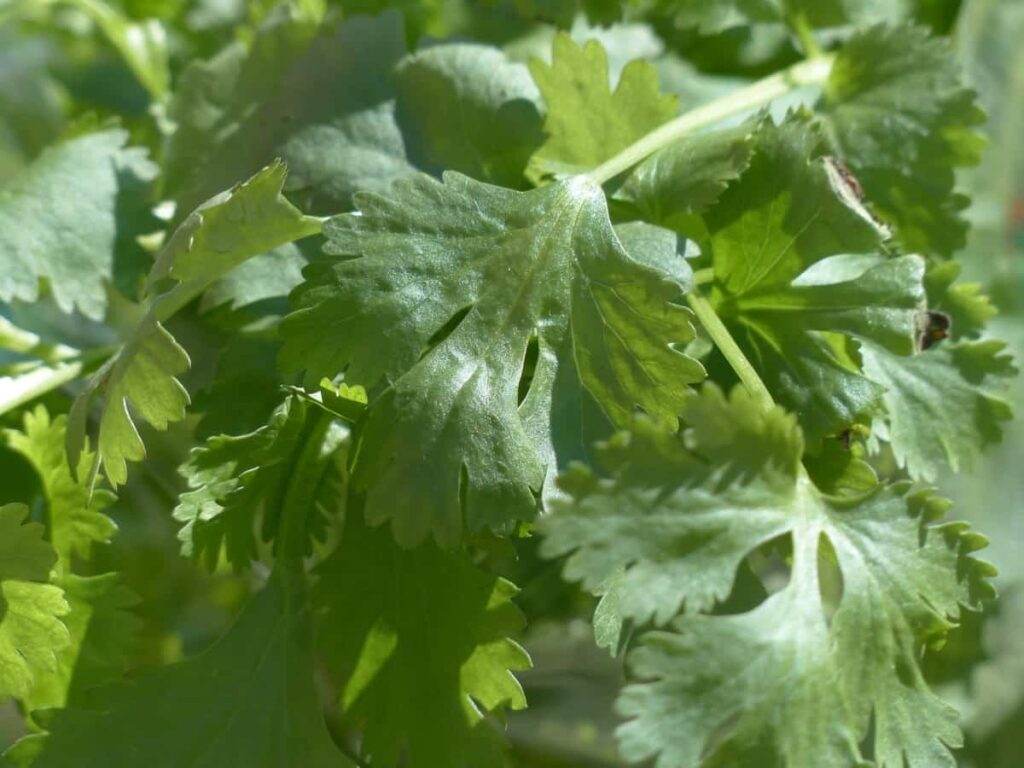
If we erase the investment from his income, we will profit nearly 1,73,000 rupees. Also, if we take away the four-month lease from this figure, his profit would be about 1,33,000 rupees. This is a very decent profit for short-crop cultivation. Mr. Ashalu is very happy and is considering taking another 1-acre land on lease. This wants farmers to end this type of cultivation as it has many advantages and has the potential for huge profits.
- Types of Pesticides Used in Agriculture: A Beginner’s Guide
- Economical Aquaculture: A Guide to Low-Budget Fish Farming
- 15 Common Planting Errors That Can Doom Your Fruit Trees
- How to Make Houseplants Bushy: Effective Tips and Ideas
- Innovative Strategies for Boosting Coconut Pollination and Yield
- Pollination Strategies for Maximum Pumpkin Yield
- The Complete Guide to Chicken Fattening: Strategies for Maximum Growth
- Natural Solutions for Tulip Problems: 100% Effective Remedies for Leaf and Bulb-Related Issues
- Revolutionizing Citrus Preservation: Towards a Healthier, Greener Future
- Natural Solutions for Peony Leaf and Flower Problems: 100% Effective Remedies
- Maximizing Profits with Avocado Contract Farming in India: A Comprehensive Guide
- Natural Solutions for Hydrangea Problems: 100% Effective Remedies for Leaf and Flowers
- The Ultimate Guide to Choosing the Perfect Foliage Friend: Bringing Life Indoors
- From Sunlight to Sustainability: 15 Ways to Use Solar Technology in Agriculture
- The Ultimate Guide to Dong Tao Chicken: Exploring from History to Raising
- The Eco-Friendly Makeover: How to Convert Your Unused Swimming Pool into a Fish Pond
- Mastering the Art of Delaware Chicken Farming: Essentials for Healthy Backyard Flocks
- 20 Best Homemade Fertilizers for Money Plant: DIY Recipes and Application Methods
- How to Craft a Comprehensive Free-Range Chicken Farming Business Plan
- Brighten Your Flock: Raising Easter Egger Chickens for Beauty and Bounty
- How to Optimize Your Poultry Egg Farm Business Plan with These Strategies
- Subsidy for Spirulina Cultivation: How Indian Government Schemes Encouraging Spirulina Farmers
- Ultimate Guide to Raising Dominique Chickens: Breeding, Feeding, Egg-Production, and Care
- Mastering the Art of Raising Jersey Giant Chickens: Care, Feeding, and More
- Ultimate Guide to Raising Legbar Chickens: Breeding, Farming Practices, Diet, Egg-Production
- How to Raise Welsummer Chickens: A Comprehensive Guide for Beginners
- How to Protect Indoor Plants in Winter: A Comprehensive Guide
- Ultimate Guide to Grow Bag Gardening: Tips, Tricks, and Planting Ideas for Urban Gardeners
- Guide to Lotus Cultivation: How to Propagate, Plant, Grow, Care, Cost, and Profit
- Agriculture Drone Subsidy Scheme: Government Kisan Subsidy, License, and How to Apply Online
- Ultimate Guide to Raising Araucana Chickens: Breed Profile, Farming Economics, Diet, and Care
- Bringing Hydroponics to Classroom: Importance, Benefits of Learning for School Students
- Ultimate Guide to Raising Polish Chickens: Breed Profile, Farming Economics, Diet, and Care
- Ultimate Guide to Raising Australorp Chickens: Profile, Farming Economics, Egg Production, Diet, and Care
- Silkie Chicken Farming: Raising Practices, Varieties, Egg Production, Diet, and Care
- Sussex Chicken Farming: Raising Practices, Varieties, Egg Production, Diet and Care